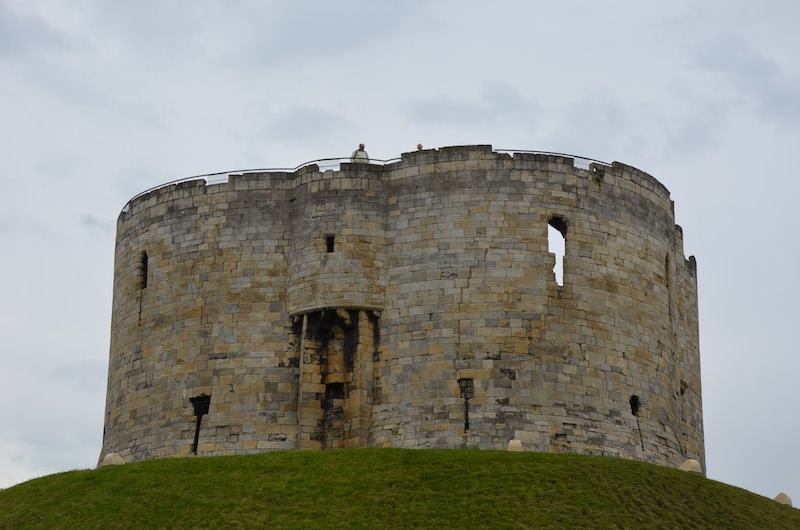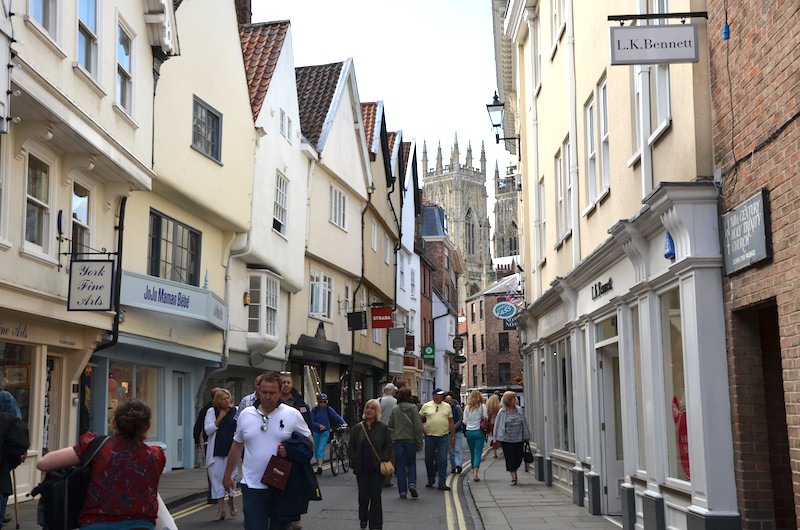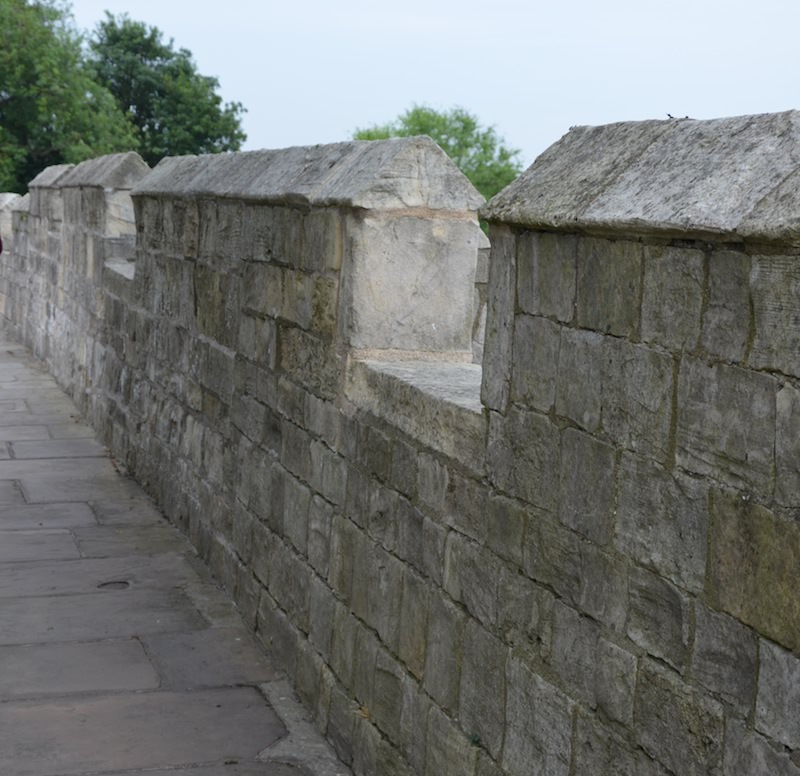The Romans knew it as Eboracum. To the Saxons it was Eoforwick. Then the Vikings named it Jorvik. Today we know it as York, England. In Roman times York became such a well-established political and commercial center that people lived on here for millennia afterwards. The city still bears evidence of all its eras and occupations.
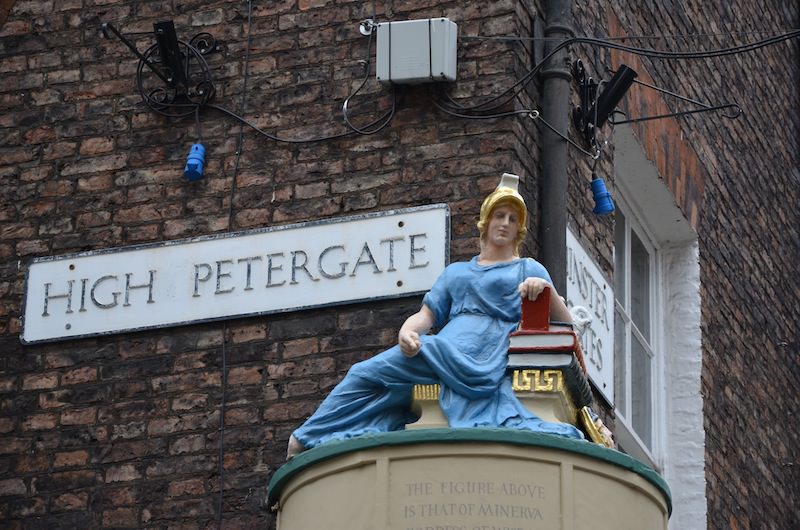
Watch for the beautiful blue painted statue of Minerva on High Petergate, leaning on a stack of books.
Due to the numerous uncovered artifacts (many of which can be seen in the town’s numerous museums), and its plethora of ancient buildings, scholars have long recognized York as one of England’s finest historic cities. Here’s a York history tour you can do in a day or two. Note: If you do this tour in this sequence you will not have to double back on your tracks.
Micklegate Bar and Museum
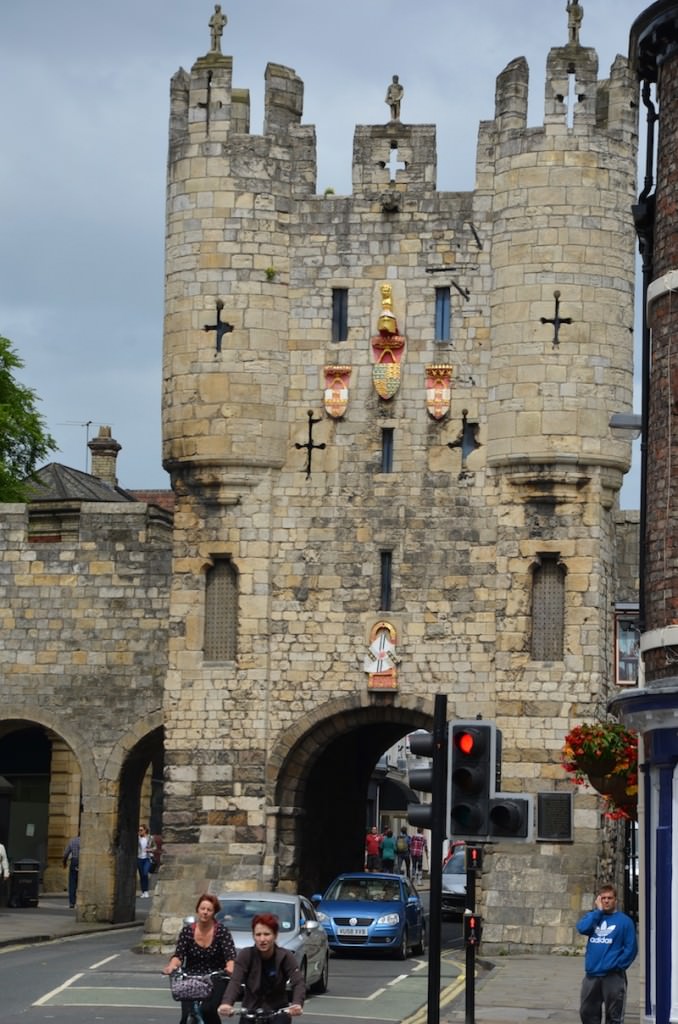
Micklegate Bar is really more like a castle tower. And it’s been nicely converted into a small museum that gives the perfect crash course in York’s long, fascinating, and bloody history to the first time visitor.
A “Bar” is the name given to the tall, ancient city gates that dates back 8 centuries. To the eye it’s really more like a castle tower. And it’s been nicely converted into a small museum that gives the perfect crash course in York’s long, fascinating, and bloody history to the first time visitor. Here you can learn about Richard of York, early pageantry, the church in medieval life, the city authorities, the wardens, watchmen, masons, and the prisoners kept here. Exhibits include armor, helmets, costumes, a short film, a pile of skulls, and masks.
York Army Museum
Visitors with a military bent should check out the Museum of the Royal Dragoon Guards and the Prince of Wales’s Own Regiment of Yorkshire. It makes a great 1-2 hour visit. This quintessential English regimental museum displays some very interesting galleries and artifacts.
Clifford’s Tower
This stark stone tower, standing on the top of a small hill opposite the York Castle Museum was once the town’s central stronghold. Not too much to see here, but it’s worth a quick look inside.
York Castle Museum
This large museum offers much in the way of costumes, and military and social artifacts from the past 400 years. The reconstructed Victorian Street is superbly done, and standing in its dimly lit alleyway takes you back to that era. Also well worth visiting are the period rooms from Jacobean, Georgian, and Victorian times.
Jorvik Viking Centre
Today, when you visit the Jorvik Viking Centre located in the Coppergate area of York, you’re standing on the exact place where the Jorvik Viking village stood in the 10th century. Even more impressive, the buildings you see in the recreated Viking village are in the exact positions where they were discovered. Inside the Viking Center’s entrance you can view part of the archeological dig. Standing on thick plate glass you look down at dozens of artifacts and house foundations inset into the earth.
Next, you walk through a time tunnel to the Viking village. Boarding a flying time capsule you take off for a flying tour of the houses, workshops, backyards, rubbish pits, wells, and latrines. To make your Viking village tour more authentic, the smells have been recreated too!
Merchant Adventurer’s Hall
Considered the finest surviving medieval Merchant’s Hall in Europe, this timber-framed guildhall once echoed with the wheelings and dealings of the Merchant Adventurers. One of York’s most prestigious unions, this high ceilinged hall has stood for over 600 years.
Barley Hall
Discovered by accident in the 1980s, this medieval town house has been restored to its former state as the abode of Alderman Snawsell, a goldsmith, and another distinguished tenant, the Lord Mayor of York.
York Minster
As Britain’s largest cathedral, you’ll need some time to explore this massive edifice. The spiritual home of the Archbishop of York, construction of the minster began in 1220 and lasted 252 years. Chambers and anterooms to explore in the minster include the Undercroft, the Treasury, the Crypt, the Central tower, the Chapter House, and the surrounding Minster Close.
York’s Atmospheric Alleyways
York boasts numerous small, funky side alleys—called snickleways—that wind their way through the city center. The streets were deliberately made narrow to keep the meat in the butcher’s shoppes out of the sunlight. Littered with discarded bones, blood, and offal, conditions in the snickleways led to York’s periodic outbreaks of the plague. Even as you stand near the perfectly restored buildings—many of them cafes and boutiques—and in immaculately tidy and clean streets, it’s not a stretch to imagine being here in medieval times with throngs of noisy, unruly people and pandemonium reigning.
Take some time to read the alley names to get the feeling for olde tyme York, like Mad Alice Lane and Swinegate, that refer to some former residents. The most famous of these side alleys, The Shambles, is the oldest shopping street in Europe.
High Sculptures
The English have a saying that when things get tough, you should “keep your chin up’. This applies when you’re visiting York, although for a different reason. The town is dotted with dozens of small wooden and stone carvings and figurines that look down at you from street signs, building corners, and churches. Watch for the beautiful blue painted statue of Minerva on High Petergate, leaning on a stack of books. A sign on her round pedestal tells that she was carved in 1801 by sculptor was John Wostenholme.
Perhaps the most intriguing figure skulking above York’s streets is the black-bearded and horned Devil, staring from his perch at No.33 Stonegate. You can’t miss this bright red devil. He’s a tribute to the printer’s devils, who worked here back in the day; errand boys who carried the hot metal type. Elsewhere around town, look for stone griffins green with moss, and a large suspended golden ram hanging outside the Golden Fleece pub.

Perhaps the most intriguing figure skulking above York’s streets is the black-bearded and horned Devil, staring from his perch at No.33 Stonegate.
And there’s a marvelous collection of small stone-carved gargoyle heads, faces, and cherubs in the octagonal Chapter House of the towering York Minster. Each face exudes character and personality and gives a glimpse into 13th century York.
Outside the Minster—once the former site of Rome’s military headquarters—you’ll see a life size bronze statue of Roman Emperor Constantine the Great seated on a throne, holding his sword. Crowned in York in 306AD, Constantine is the only Roman emperor to have been crowned outside Rome.

Outside the Minster—once the former site of Rome’s military headquarters—you’ll see a life size bronze statue of Roman Emperor Constantine the Great seated on a throne, holding his sword.
Yorkshire Museum
Although this museum is last on my list, it’s definitely not the least! The galleries are treasure troves of historical artifacts that date back for two millennia, and include Roman, Saxon, Viking and Medieval finds. Plan on 1-2 hours to viewing these fascinating exhibits thoroughly.
Walk the Roman Walls
About 2.5 million people walk the City walls each year, past 45 towers and five gateways. It’s a great way to get an overall feeling for York, and I highly recommend it. The walls are 3.4 kilometers long, and provide some amazing views within and without the city. Accessed from several points around its circumference, the entire wall takes about 2 hours to stroll.
York is a target rich place for tourists and its finely honed tourism infrastructure brings tears to the eyes of a travel writer. Plan on spending at least two nights here to allow time to see the main attractions. Any less time, and you’ll leave feeling shortchanged.
If You Go
Mount Royale Hotel
Listed as a William IV Building, with a large English garden, the Mount Royale has a relaxing old-world feel with all modern hotel luxuries. It’s within easy walking distance of downtown historic York attractions. The hotel’s restaurant is considered fine dining.
117 The Mount
York
YO24 1GU
The York Pass
The York Pass gains you entry to over 30 York attractions including the ones mentioned above and saves a considerable amount of money if you visit several attractions. Passes are available for 1, 2, or 3 days.
York Walk
These low-cost and high quality history walks help the visitor get to know the city better. Walks range from Essential York to Secret York, plus a number of special walks like literary York, Bloody Execution Tour, Riverside Walk, Hidden York, etc.
YorkBoat
Boat tours of parts of York are accessible by river.
Haunted York
York is reputed to be the most haunted city in Europe. Take your pick from several haunted York tours.
- www.ghostwalkyork.co.uk
- www.ghostwalk.ofyork.co.uk
- www.ghosttrail.co.uk
- www.ghosthunt.co.uk
- www.ghostdetective.com
Written by and photos by Roy Stevenson for EuropeUpClose.com

